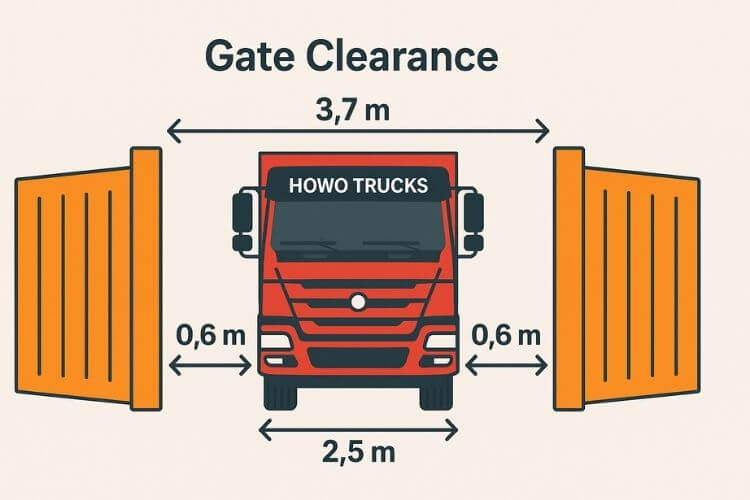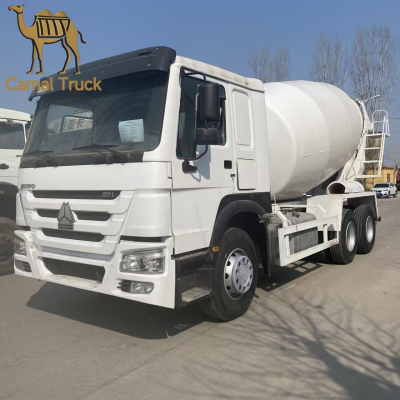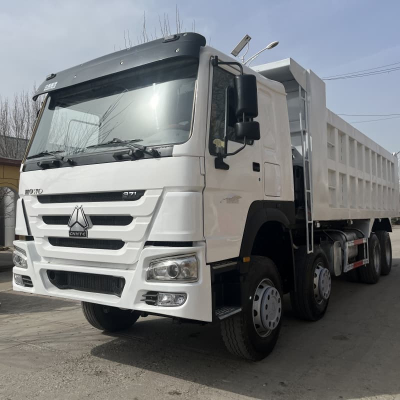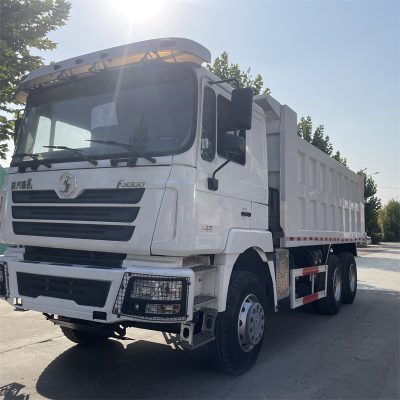How Wide is a Dump Truck?
“How wide is this thing, exactly?” Many of you may have asked this question, watching a tipper make its way through a site entrance. Width, you see, is a critical determinant of all things related to these questions: the roads you can drive on, the gates you can pass, the ramps you can drive up, and even the trailers you can hire or purchase to move your haulers around. Well, this article will walk you through a simple, easy-to-understand explanation related to dump truck widths, as well as how you can better plan a job, especially if you are adopting a standardized approach utilizing Howo trucks hardware in your projects related to either the construction or mining industries. We will compare how a Howo Truck compares to the usual world expectations related to this matter, including sizes and regulations you should know around the world.
The Simple Answer to This Question
A standard width for dump trucks will be approximately 8-8.5 feet or 96-102 inches/2.44-2.60 meters wide, measured across the largest part of the vehicle, exclusive of any legally exempted side mirrors, as they are commonly defined today.
The vast majority of modern tipper trucks will be designed to just fit under the legally mandated maximum, which will usually be nearer 2.49-2.55 m wide, measured across the vehicle body and tires, while the largest types will often approach or even exceed 3 meters or even considerably more, as seen with mine-haul trucks.
That is the headline. The detail that follows is just as important, as “width” will depend on body type, tires, and even an optional handrail.
What Counts as Width?
Before citing any figures, you should define what exactly you are measuring:
l Overall Vehicle Width (OVW): The maximum fixed point of a truck body or chassis, commonly measured between the sidewalls of the tires or the dump truck bodies outside guards, but with laws often disregarding the mirrors as well as safety rails.
l Body Width: The actual box, measured from outside to outside. One “2.3 m body” may have axles so that the total is wider.
l Operating Width: The truck requires to move effectively on site, taking into account any sway, berm, or driver margins.
When you spec or purchase, you can ask suppliers to specify overall width and body width, as well as point out bolt-on components that may just put you over a gate or a lane-width restriction, as you compare Howo trucks, which are often suited for both on and off-road applications.
Typical Widths by Class
l Light/medium On-road Dump Trucks: Approximately 2.3–2.45 m wide (7.5–8.0 ft). Commonly used for urban muck-away and small aggregates.
l Full-size Highway Dump Trucks: Tandem or tri-axle, approximately 2.49–2.55 m (8.2–8.5 ft). Most fleets seek out the legal maximum for payload efficiency.
l 8×4 Construction/Mining Tippers: Often 2.49–2.55 m overall, with bodies circa 2.3 m wide and tyres projecting to, or near, the legal limits. Many export-spec Howo trucks sit right here, balancing capacity with lane access.
l Articulated Dump Trucks (ADTs): 2.9–3.5 m and up, depending on payload class. Not intended for public road use without special permits.
l Ultra-class Mining-use Trucks: Far wider, these live inside the mine and only move by special heavy transportation.
If you're mixing in urban streets with site haul roads, that 2.49–2.55 m band is the sweet spot, which is why so many Howo trucks are dimensioned to stay under that line.
What the Law Allows (At a Glance)
l Most States in the US: Legal maximum width of those commercial vehicles like Howo trucks on interstates or primary roads is 102 inches or 8.5 ft/2.6 meters (rearview mirrors and some safety devices excluded). By contrast, the regulations of local streets may be much stricter.
l EU Countries: Generally speaking, the maximum width is 2.55 meters while 2.6 meters for some trucks with insulated truck bodies (Rearview mirrors excluded). However, you should also refer to different regulations of local municipal roads from different countries.
l UK: Similar with the standard of EU countries, the maximum width of most dump trucks is restricted to 2.55 meters.
l Australia and New Zealand: 2.5 meters is the maximum width limit in both 2 countries, which can fit general access. Dump trucks or used dump trucks with larger width ask for permits or specified routes.
l African, Middle Eastern and Southeastern Countries: The maximum width of imported dump trucks or used dump trucks and CKD assembled vehicles usually range from 2.5 meters to 2.55 meters. However, different countries have different regulations.
Do remember to schedule your running routes well ahead of knowing the regions that you are locating. A low-height stone gateway or narrow bridge may bring you some trouble because of the improper trucks’ width. For example, fleet importers or buyers of howo trucks often select to combine a body and tyre together and make the overall width range between 2.5 meters and 2.55 meters. In this way, this combo can work in most areas of their countries.
Overall Width vs. Body Width: Why They Differ
You may see the "Body Width 2.3m or 2300mm" in the TDS, nevertheless, this cannot represent the real overall width of a dump truck is 2.3 meters or 2300 millimeters. Want to know the reasons?
l Tyre Bulge: Heavy tyres, like 12.00R20 or 315/80R22.5, may bulge by several centimeters on both sides.
l Side Walls, Rub Rails, or Rock Stone Guard can help to widen the upper box by adding protective steel.
l Wheel Spacers: They can take a great effect in improving the stability and adding track width.
l Mudguards and Fenders can add the overall width of a dump truck or used dump truck like Howo trucks.
l Handrails or Ladders: Some of them can be exempted while others can be counted into overall width
In a word, the overall width of dump trucks or used dump trucks should be listed clearly when you plan to make a purchasing order. In this way, these dump trucks or used dump trucks (i.e. Sinotruk Howo Trucks) can arrive at the site by running smoothly.
How Width Affects Your Site Plan
Gateways and Access Roads
The most common rule applied is the add-up of truck's OVW and a clearance of 600 mm (≈ 2 ft) for one-way passage through side. If the length of the pillars at your gate is just right, the time lost inching through will destroy the productivity of the whole day.
Lane Sharing and Passing Points
About 1.0 to 1.5 m more space is needed for two trucks passing each other comfortably, which means you have to measure 2 × OVW + that extra distance. If you cannot afford that amount, do not let yourself hope for miracles on blind bends by marking passing bays instead.
Berms and Safety Edges
Usable width is taken by berms on bench roads. Educate your drivers not to touch the berm with a tyre or they will get sidewall cuts, which means your road must be wider than what raw OVW math suggests.
Tipping Areas
Bigger cones should be used around hoppers and bins. A truck of 2.55 m should not be passing through a pocket of 2.7 m, the chances of mirror, fender or tailgate damage are greatly increased.
Operators of Howo Trucks for quarries have made a rough standard of 4.5–5.0 m for one-way haul lanes and 7.0–7.5 m for two-way segments where passing can happen without stopping the flow, among other parameters.
Transporting the Truck: Width on a Low bed
If your unit moves to site on a trailer:
l Deck Width: Low-bed must be wider than your tyre shoulders. A 2.55 m truck on a narrow deck is impossible to transport.
l Chains/Straps: Lashing points should be at angles that do not touch the sidewalls.
l Permits: Even if the truck is under the legal limit, the combo might still breach a bridge or local restriction.
Normally, export fleets move Howo Trucks as drive-aways to ports when it is legal and safe, specifically to avoid oversized headaches.
Width and Body Choices
Selecting between earth and rock bodies affects the weight and sometimes the total width:
l Earth Body (for instance, 8/6 mm floor/side): Lighter, usually the same externally but has less bulk of side-wall mass. Climbing faster, suitable for sand, soil, and gravel.
l Rock Body (for example, 12/10 mm): Heavier with more powerful side guards and sometimes a little wider top rail. Perfect for blasted stone and giant aggregate.
If you are using Howo Trucks, you can build either of them in the same 8×4 envelope, but be careful with the side-wall extras that could slightly increase the width at the top of the box.
Tyres, Track, and Stability
The choice of tyres and setup of the rear axle affects the ground width:
l 12.00R20 is a standard size for export tippers. It provides excellent off-road bites and is available in large quantities.
l 315/80R22.5 is a size used often when radial 22.5" tyres are less expensive or more accessible.
Changing the size may possibly vary the track by a few centimeters and affect the distance to the legal limit you can go. Fleet managers who operate Howo Trucks in different countries occasionally make tyre size uniform to make the total width easily predictable. What’s more, the availability of truck parts will not be problematic.
How Wide Is an 8×4? A Practical Range
A standard 8×4 highway tipper that is mainly used for construction and quarry work has the following dimensions:
l Overall Width: 2.49–2.55 m.
l Body Width: Usually 2.30 m.
l Mirror-to-mirror: It is frequently exempted by law (still matters for gateways and trees).
Most Howo Trucks manufactured for mixed on/off-road usage fall within that range. You can expect the same size envelope from many used dump truck manufacturers since legal and operational considerations force everybody to the same position.
Don't Miss Regional Alerts
l U.S.: Maximum height allowed on interstates is 102 in (8.5 ft) but local lanes and weight-posted bridges may be tighter.
l EU/UK: 2.55 m is the standard line while refrigerated bodies often get 2.60 m.
l Australia/NZ: 2.5 m general access, wider units need to go through permits and route planning.
l Developing Markets: It is not only about the law but also about the gates, the village main street, and the old bridge that you need to get through. So, first measure your worst pinch point.
If you are transporting Howo Trucks to a new area, before deciding on the body and tire options, check the narrowest gate or lane on your route.
Planning Checklist (Use This Before You Buy)
1. First, measure the tightest gate in the access route and on site.
2. Confirm the legal width on the roads you will be using the most and not just the maximum highway.
3. Specify both total width and body width in your purchase order.
4. Select the type of body (earth vs. rock) with consideration of side-wall add-ons.
5. Tyre size has been confirmed to monitor and keep the availability consistent.
6. Margin should be allowed: target at least ≥ 300 mm clearance on each side at the tightest point.
7. Prepare the drivers for strict adherence to the lane and the practice for the clearance of the berm to avoid damage to the tyres and mirrors.
One reason why multi-site operators prefer Howo trucks is the standardization of this list. The dimensions of the platform are certain, and the flow of parts is strong through ports and borders.
Frequently Asked Questions
Question 1: Does legal width account the mirror width?
A: The answer is no in a lot of places—mirrors are counted as exceptions. Yet they still touch gateposts, thus it is a good idea to think of them as part of your operational width.
Question 2: Is it true that all the tipper bodies have the same width?
A: No, not really. The two boxes marked “23–26 m³” can actually have different outside widths based on the sidewall structure, top rails, and guards.
Question 3: What if my site is very tight?
A: Select an 8×4 that is definitely close to 2.49–2.50 m, use an earth body with no additional guards, and DO NOT use wheel spacers. Some fleets will run narrower tyres during winter to get a few more centimeters, but you’d better check load ratings in advance.
Question 4: Will a truck with a bigger width always have a bigger load?
A: Not always. The payload is based on maximum weight limits, body volume, and type of material. Many Howo Trucks have a good cost per ton at standard width as they are legal everywhere.
Question 5: Is it possible to alter the width after the purchase?
A: Yes, but not by much. You can do it through tyre selection or by the removal of some bolt-ons, though the chassis track remains constant. It is better to choose for the narrowest gate you will ever need.
Conclusion
The question “how wide is a dump truck” nearly always points to the same answer: 2.5–2.55 m for full-size, on-road tippers and even more for off-road articulated units. While the number is important, so are your clearance margin, body choice and tyre plan. If you are creating or enlarging a fleet, then spec for the tightest gate that you will ever face rather than for the widest highway that you will ever see. This method guarantees that trucks keep moving, no mirrors or tyres get damaged, and delivery re-working can be avoided.
For the buyers of Howo trucks, the platform is quite literally in the perfect spot for legal width, body flexibility, and parts availability. By paying close attention to overall width against body width, and by allowing a few centimeters of margin at every pinch point, you will not only be able to keep your schedule intact but also have your cost per ton right where it belongs.

















